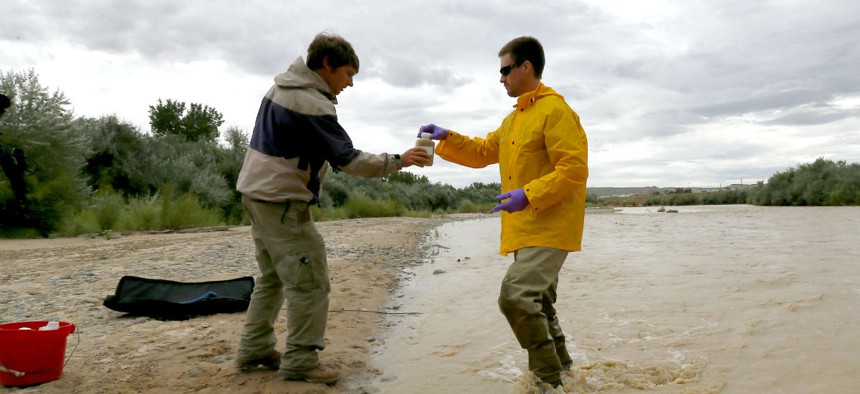
State officials take a sample from the San Juan River in Utah, which was affected by the spill. Matt York/AP
The EPA Is Working With Several Federal Agencies to Clean Up Its Self-Created Disaster
Millions of gallons of toxic water have leaked into major rivers thanks to an EPA mistake.
The Environmental Protection Agency has deployed dozens of employees to respond to its release of a mine’s wastewater into two rivers in at least three southwestern states, and is coordinating with several federal entities to clean up the massive spill that has caused the governor of Colorado to declare a state of emergency.
The spill at the defunct Gold King Mine began last week when an EPA inspection crew was investigating existing leakages. While excavating loose material in the mine, pressurized water burst out of a tunnel and into a creek that fed into the Animas River. About 3 million gallons of the wastewater has flowed from the mine since the incident.
The EPA has apologized for the incident and sent “large” response teams to various locations in Colorado, New Mexico and Utah. In addition to its own employees -- including 10 “on-scene coordinators” and 21 employees providing support services at the Denver regional office -- the EPA has used existing contracting mechanisms to rapidly hire companies to help with water quality sampling, drinking water and agricultural water distribution, and construction and maintenance of water treatment ponds.
The leakage has caused water contaminated with metals from the mine to move downstream into water sources for drinking and agriculture. EPA’s regions 8 -- which was responsible for the incident -- 6, and 9 are all part of the agency’s response.
The EPA’s response has included creating settling ponds near the mine to treat the water with various solutions and agents that trap the metals in the ponds. So far the EPA is optimistic, but not certain, its efforts are working.
“The treatment appears to be effective,” the agency stated.
Also involved in the effort is the U.S. Geological Survey, which has measured the flow of water from the mine. The Health and Human Services Department has enlisted its U.S. Agency for Toxic Substances and Disease Registry to assist local officials in coordinating the public health response. ATSDR said it would be available to physicians in the area with questions on the health risks.
The wastewater has moved “in the vicinity” of the Navajo Nation boundary, EPA said, and the Bureau of Indian Affairs is working with its residents to take precautionary measures. The EPA has deployed several of its Region 9 employees to assist in that effort, including the testing of water.
The Fish and Wildlife Service is also working to ensure fish in the river are healthy, and to date has found “no indication of widespread fish mortality.” The agency will continue to provide capture and oversight of the testing of wildlife for New Mexico.
The San Juan River was also affected, and the EPA said it is testing both rivers daily. The agency expects the Animas to remained closed for activities until at least Aug. 17.
Much of the Animas River turned orange as the mine water flowed into it, causing great concern among residents living near it. The EPA said arsenic levels in the Durango, Colo., area of the river showed 300 times the normal level of arsenic and 3,500 times the normal level of lead. Officials have advised residents in affected areas to test their water before drinking it, but it is currently “not considered potable.” The EPA and New Mexico Environment Department are providing free water quality testing for domestic drinking water wells along the river. Technicians are going door-to-door to collect samples for testing, EPA said.







